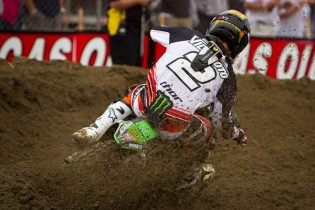
WORDS SHANE BOOTH | PHOTOGRAPHY CADE MEDIA
As you improve and start to race higher-profile events, anything from state level and upwards, you will find the track prepared a little differently from your average club day. The track will most likely be ripped and well watered, it will be deep and muddy in practice then, in theory, come good for racing without the need for additional watering throughout the day. These conditions will produce deep ruts and lots of them. Most corners will have a whole bunch of options and picking the correct one makes a big difference.
BE AWARE
When a track forms up with plenty of deep ruts it’s so easy to get flustered and stick to using the same line lap after lap. It’s a trap you need to try to avoid. It all comes down to the level of awareness you have when riding — the more aware you are of the changing track conditions, the more likely you are to choose the best line. It’s easier said than done. In this case you need to be looking for other lines in the turn while dealing with the rut you’re in. It’s a skill that comes with time and experience in these conditions. Pro riders will be scanning the track the whole time they’re racing at full speed, looking for a better line that may save them a 10th here and a 10th there. Here’s a basic rule to remember: if you’re really struggling with a line, change it! Sounds obvious, but the number of riders you can watch struggle with something lap after lap and not try a new line is amazing. Most of the time there will be a better one.
WHAT TO AVOID
To choose a good line you need to know what you’re looking for — or looking to avoid. Ruts like the ones here are more unforgiving than most, due to the fact they are clay and have dried so hard. In softer ruts, if you make a big mistake sometimes you’ll get away with it because the bike will push out of the rut. Not in these ones — they’re deep and have set like concrete. Once you’re in, that’s it. Start with the rut closest to the inside of the turn; this is the shortest way around the corner and usually the quickest. You are looking for a rut that has a smooth arc and the fewest bumps and is deep enough to hold the bike. If possible, avoid ruts that have formed a deep hole at the apex or tighten up drastically at any point. Extremely rough exits will limit your drive, so if you can avoid those too you will carry better exit speed. Occasionally ruts can get too deep, which will cause your legs to get caught up and maybe even some parts of the bike. If you’re facing any of those problems, look for a new line. You won’t always be able to find a good rut; in those cases it’s a matter of picking the best of a bad bunch.
5 Tips to picking the best rut
1. Start with the rut closest to the inside of the corner — it’s the shortest distance around the turn. If it’s no good, work your way one rut at a time to the outside until you find a suitable one.
2. The smoother the arc of the rut, the easier it is to carry speed and stay smooth.
3. A few bumps are fine, but if it really affects your drive look for a new line.
4. Deep is OK, bottomless is not. If the rut is too deep it can be slow; change up your line if you can.
5. Keep in mind where the rut leaves you on the exit — this can determine which one you choose.



